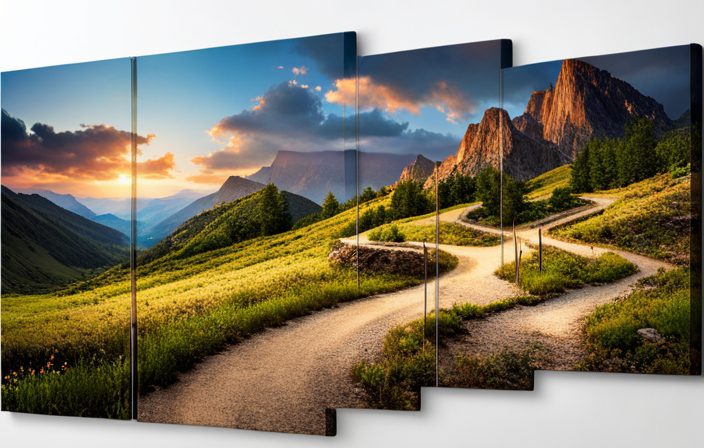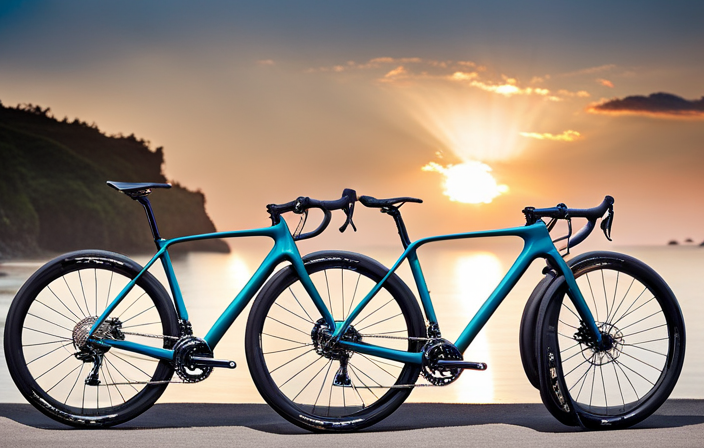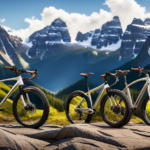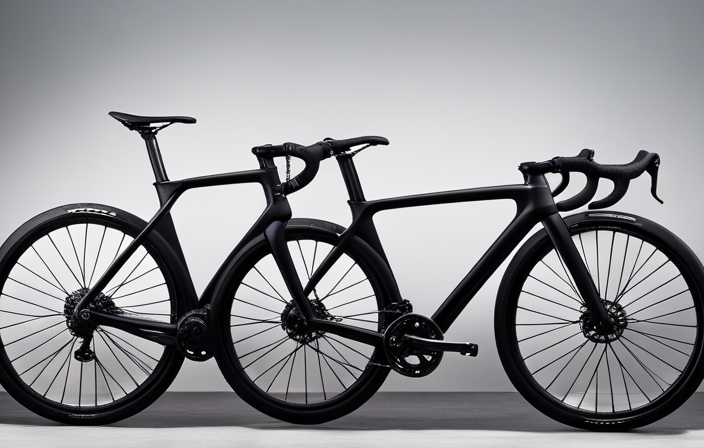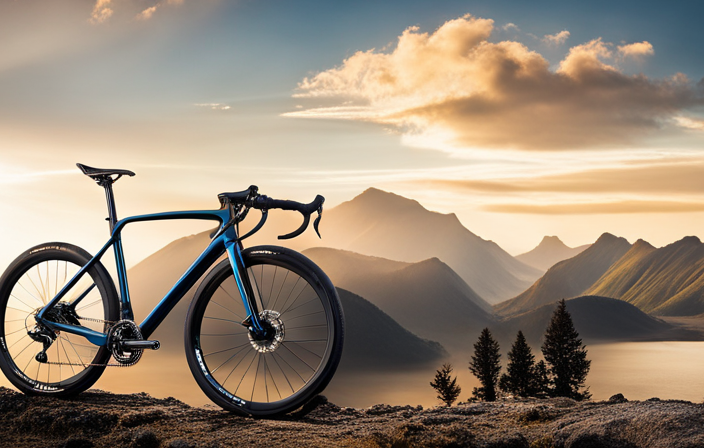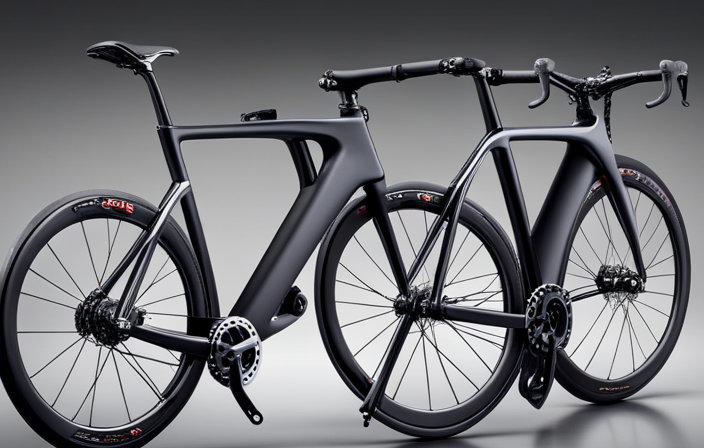Are you struggling to decide between taking on challenging trails on a mountain bike or exploring diverse terrain on a gravel bike? It can feel overwhelming like being at a crossroads. But don’t worry! I’m here to help you navigate the decision-making process between these two amazing bikes.
Strap in as we delve into the differences in frame design, tire selection, gearing, and more. By the end of this article, you’ll have all the tools necessary to make an informed decision that suits your riding style and goals.
Let’s hit the trail!
Key Takeaways
- Mountain bikes excel in rough, technical terrains like rocky trails and steep descents, while gravel bikes are built for less extreme terrains like dirt roads and smooth trails.
- Mountain bikes have sturdy frames and suspension systems for shock absorption, while gravel bikes have lightweight frames and less robust suspension systems.
- Mountain bikes have wide and knobby tires for excellent traction on loose surfaces, while gravel bikes have tires designed for efficiency on paved surfaces.
- Mountain bikes offer a more aggressive riding style with quicker acceleration, while gravel bikes provide a more comfortable and relaxed ride for endurance-focused biking.
Understanding the Terrain: Mountain Bike vs Gravel Bike
If you’re not sure which bike to choose, understanding the terrain can help you decide between a mountain bike and a gravel bike. When comparing the performance of these two types of bikes, it’s crucial to understand the differences in terrain they are designed for.
Mountain bikes excel in rough, technical terrains such as rocky trails, steep descents, and muddy paths. They are equipped with sturdy frames and suspension systems that absorb shocks and bumps along the way. The wide and knobby tires provide excellent traction on loose surfaces, ensuring stability and control during challenging climbs or descents. With their aggressive geometry and powerful brakes, mountain bikes offer a thrilling ride for adrenaline junkies seeking off-road adventures.
On the other hand, gravel bikes are built for less extreme terrains like dirt roads, gravel paths, or smooth trails. They feature lightweight frames with relaxed geometries that prioritize comfort over agility. Gravel bikes usually have narrower tires than mountain bikes but still offer enough grip on loose surfaces. Their suspension systems are less robust compared to mountain bikes but can still handle moderate vibrations.
Understanding these differences in terrain will guide your decision-making process when choosing between a mountain bike and a gravel bike.
Now let’s explore the next section about differences in frame design and suspension systems without wasting any more time.
Differences in Frame Design and Suspension Systems
The frame design and suspension systems of mountain bikes and gravel bikes vary significantly. These differences have a direct impact on the bike’s performance, handling, and overall stability. When it comes to off-road biking, suspension plays a crucial role in absorbing shocks and providing a smooth ride. Mountain bikes typically feature front and rear suspension systems, allowing riders to tackle rough terrains with ease. Gravel bikes, on the other hand, usually have limited or no suspension at all, as they are designed for smoother surfaces.
To highlight the importance of frame design and suspension systems in these two types of bikes, let’s take a look at the following table:
| Bike Type | Frame Design | Suspension System |
|---|---|---|
| Mountain Bike | Sturdy and durable construction | Front and rear suspension system |
| Gravel Bike | Lightweight frame for agility | Limited or no suspension |
As you can see from the table above, mountain bikes prioritize sturdiness to handle rugged trails while offering both front and rear suspensions for maximum shock absorption. On the other hand, gravel bikes focus on lightweight frames that provide agility on smoother surfaces.
The next section will delve into another important aspect when deciding between a mountain bike vs gravel bike: tire selection – knobby vs smooth.
Tire Selection: Knobby vs Smooth
When considering tire selection, riders must decide between knobby and smooth options. The choice between knobby and slick tires depends on the specific needs of the rider. Here are three important factors to consider:
-
Traction: Knobby tires with their aggressive tread patterns excel in providing traction on loose or uneven terrain like dirt trails or muddy paths. The deep knobs help grip the surface, allowing for better control and stability when riding off-road. This makes them a suitable choice for mountain biking, where maintaining traction is crucial.
-
Speed: On the other hand, smooth or slick tires are designed for efficiency on paved surfaces like roads or gravel paths. With minimal tread patterns, these tires reduce rolling resistance and promote higher speeds. They allow for smoother rides by minimizing vibrations and allowing the bike to glide more effortlessly.
-
Versatility: Some riders may prefer a compromise between traction and speed by opting for semi-slick tires that combine elements of both knobby and slick designs. These tires feature a smoother center section for reduced rolling resistance while still having some side knobs for improved cornering grip.
Considering your riding style, terrain preferences, and desired performance characteristics will help you make an informed decision between knobby vs slick tire options.
Transitioning into the subsequent section about gearing and shifting: climbing vs speed, it’s important to understand how different gear ratios can impact overall performance on various terrains without compromising efficiency during climbs or high-speed descents.
Gearing and Shifting: Climbing vs Speed
Consider your riding style and the terrain you’ll be tackling to determine the optimal gear ratios and shifting techniques for climbing or achieving higher speeds. When it comes to gearing and shifting, mountain bikes and gravel bikes have different needs. Mountain bikes typically have a wider range of gears with lower ratios, allowing for better climbing efficiency on steep trails. This is essential for maintaining traction and power when going uphill. On the other hand, gravel bikes prioritize speed on flatter or rolling terrains, so they often have closer gear ratios that enable smoother transitions between gears at higher speeds.
To illustrate the differences in gearing and shifting between these two types of bikes, let’s take a look at this table:
| Mountain Bike | Gravel Bike | |
|---|---|---|
| Climbing | Lower gear ratios | Closer gear ratios |
| Speed | Higher gear ratios | Closer gear ratios |
| Handling | Maneuverability on descents | Stability on descents |
As you can see, mountain bikes are optimized for climbing steep trails with their lower gear ratios. This allows riders to maintain a steady cadence even on challenging inclines. On the other hand, gravel bikes prioritize speed by having closer gear ratios that facilitate smoother transitions at higher speeds.
Considering these factors will help you decide which type of bike is better suited to your needs. In the next section about riding style and comfort: aggressive vs endurance, we’ll explore how these factors impact your overall experience on the bike without repeating information already covered.
Riding Style and Comfort: Aggressive vs Endurance
For your riding style and comfort, think about whether you prefer a more aggressive or endurance-focused experience. Your riding position plays a significant role in determining which type of bike is right for you.
If you enjoy a more aggressive riding style, with quicker acceleration and the ability to tackle technical terrain, a mountain bike may be the better option. Mountain bikes typically have a more upright riding position, allowing for better control and maneuverability on challenging trails.
On the other hand, if you prefer a more comfortable and relaxed ride, an endurance-focused gravel bike might be the way to go. Gravel bikes often have drop handlebars that promote a more aerodynamic position, ideal for long-distance rides on smoother surfaces like gravel roads.
Consider these factors when deciding between an aggressive or endurance-focused biking experience:
- Riding Position: Choose a bike that offers the riding posture that suits your preferences.
- Handlebars: Different handlebar styles provide varying levels of comfort and control.
- Terrain: Think about whether you’ll be tackling technical trails or sticking to gravel roads.
- Ride Duration: Consider how long your typical rides are and choose accordingly.
Now let’s delve into the next section about off-road versatility: technical trails vs gravel roads without missing a beat.
Off-Road Versatility: Technical Trails vs Gravel Roads
When it comes to off-road versatility, both mountain bikes and gravel bikes have their strengths. Mountain bikes excel on technical trails, where the terrain can be unpredictable, steep, and challenging. They are designed with features like suspension systems and wider tires to handle these demanding conditions. On the other hand, gravel bikes are built for navigating gravel roads and paths with ease.
To better understand the differences between the two in terms of off-road performance, let’s take a look at this table:
| Mountain Bike | Gravel Bike | |
|---|---|---|
| Uphill challenges: steep trails vs gravel inclines | Excellent climbing ability due to low gears and robust frame | Good climbing capability with a more efficient riding position |
| Downhill thrills: technical descents vs gravel descents | Stable and capable of handling rough descents | Responsive and agile for quick maneuvering down gravel slopes |
As you can see, mountain bikes are well-suited for conquering steep trails and tackling technical downhill sections. Meanwhile, gravel bikes offer a smoother ride on less demanding inclines and descents.
Next up, we will explore how weight and maneuverability differ between mountain bikes and gravel bikes. So let’s dive into that topic without delay!
Weight and Maneuverability: Nimble vs Stable
To fully understand the differences between weight and maneuverability in nimble and stable off-road bikes, let’s take a closer look at their characteristics.
When it comes to off-road biking, the weight of your bike can have a significant impact on its performance. Nimble bikes are typically lighter, making them easier to handle and maneuver through tight corners and technical terrain. This increased agility allows riders to quickly navigate obstacles, enhancing the overall riding experience.
On the other hand, stable bikes tend to be heavier, providing more stability when descending steep trails or tackling rough surfaces. The added weight helps absorb bumps and vibrations, resulting in a smoother ride.
However, it’s important to note that these characteristics come with trade-offs. While nimble bikes excel in tight spaces and quick maneuvers, they may not provide as much stability at higher speeds or on rougher terrain. Conversely, stable bikes may feel less responsive in technical situations but offer better control and confidence when going fast or encountering challenging conditions.
In conclusion, choosing between a nimble or stable off-road bike depends on your personal preferences and riding style. Consider where you’ll primarily be riding and what aspects of handling are most important to you.
With this understanding of weight and maneuverability covered, let’s move on to exploring maintenance and durability: heavy-duty vs lightweight options for off-road biking adventures.
Maintenance and Durability: Heavy-Duty vs Lightweight
When it comes to choosing between a mountain bike and a gravel bike, there are several factors to consider. In the previous section, we discussed the importance of weight and maneuverability in determining whether you prefer a nimble or stable ride. Now, let’s delve into another crucial aspect of bike selection: maintenance and durability.
If you’re someone who enjoys exploring rugged terrains or tackling challenging trails, heavy-duty maintenance should be at the top of your priority list. Mountain bikes are designed to withstand rough conditions and require regular upkeep to ensure optimal performance. On the other hand, if you prioritize lightweight durability, a gravel bike might be more suitable for your needs. These bikes are built with lightweight materials that can withstand long rides on various surfaces while minimizing maintenance requirements.
Whether you opt for heavy-duty maintenance or lightweight durability will depend on your riding preferences and how much time and effort you’re willing to invest in bike upkeep. Consider factors such as frequency of use, terrain conditions, and personal preferences before making a decision.
Now that we’ve covered the importance of maintenance and durability in choosing between a mountain bike and a gravel bike, let’s move on to the next section where we’ll discuss price range and budget considerations.
Price Range and Budget Considerations
Considering the price range and budget will play a significant role in determining the right bike for your needs. When comparing mountain bikes and gravel bikes, it is important to consider the features they offer. Mountain bikes often come equipped with high-quality components such as suspension forks, disc brakes, and durable frames. On the other hand, gravel bikes may prioritize accessories like wider tires for stability on rough terrain and additional storage options for longer rides.
To help you visualize these differences, here is a comparison table:
| Features | Mountain Bike | Gravel Bike |
|---|---|---|
| Components | Suspension forks | Wider tires |
| Disc brakes | ||
| Durable frame | ||
| Accessories | Additional storage |
Another factor to consider is resale value. Mountain bikes are often seen as an investment due to their durable construction and high-quality components. This means that if you decide to sell your mountain bike in the future, you may be able to recoup a significant portion of your initial cost. On the other hand, while gravel bikes can also hold their value well, they may not have the same level of demand or resale potential as mountain bikes.
In conclusion, when deciding between a mountain bike and a gravel bike, it is important to consider both the features they offer and their long-term value as an investment. Next, we will explore how skill level and experience can further inform this decision-making process without writing ‘step’.
Skill Level and Experience: Beginner vs Advanced
If you’re a beginner or have advanced skills, your skill level and experience will be important factors in choosing the right bike for you. When it comes to mountain biking or gravel riding, there is a significant difference in the learning curve and progression between these two disciplines.
For beginners, starting with a mountain bike might be more suitable. Mountain bikes are designed to handle rough terrains and provide stability and control. They typically have wider tires, suspension systems, and lower gears that make it easier for beginners to navigate challenging trails. As a beginner, having a mountain bike allows you to build confidence while improving your skills gradually.
On the other hand, if you consider yourself an expert rider with advanced skills, a gravel bike could be the better choice. Gravel bikes are versatile and can handle both on-road and off-road terrains. They offer less suspension but more speed than mountain bikes. With their lighter frames and narrower tires, they allow experienced riders to tackle long distances at higher speeds.
The decision between these two types of bikes ultimately depends on your skill level and what kind of riding experience you want to pursue. Consider your comfort level with technical terrain, as well as your desire for speed versus stability.
Transitioning now into discussing bike accessories and customization options…
Bike Accessories and Customization Options
To make your riding experience more enjoyable, there are a variety of accessories and customization options available for you to personalize your bike. Whether you choose a mountain bike or a gravel bike, adding these essential accessories can enhance your comfort and performance on the trails or roads.
-
Comfortable saddle: Investing in a quality saddle can make all the difference in your riding experience. Look for one with ample padding and ergonomic design to minimize discomfort during long rides.
-
Bike lights: Safety should always be a top priority when cycling, especially if you plan on riding during low-light conditions or at night. A set of bright front and rear lights will not only make you visible to others but also help you see any obstacles ahead.
-
Fenders: Riding off-road or on gravel can kick up dirt, mud, and water onto yourself and your bike. Installing fenders will keep you cleaner and protect vital components like the drivetrain from debris damage.
Customizing your bike further allows you to tailor it to your specific needs and preferences. From upgrading the handlebars to installing tubeless tires for better traction, the possibilities are endless.
Now that we have covered essential accessories and customization options, it’s time to move onto test riding and trying out different models without committing yet.
Test Riding and Trying Out Different Models
When you go to the bike shop, take the opportunity to test ride and try out different models before making a final choice. This is an essential step in the decision-making process as it allows you to get a feel for each bike’s unique characteristics and determine which one suits your needs best. Test riding offers numerous advantages, such as allowing you to experience firsthand how the bike handles on various terrains and how comfortable it feels for extended periods of riding. It also gives you the chance to assess its responsiveness, maneuverability, and overall performance.
During your test rides, pay attention to both the pros and cons of each model. Mountain bikes excel in off-road conditions with their sturdy frames, wide tires, and suspension systems that absorb shocks. They offer excellent traction and stability but can be heavier and less efficient on paved roads. On the other hand, gravel bikes are versatile options that perform well on both pavement and light off-road trails. They are typically lighter, faster, more aerodynamic than mountain bikes but may lack some of their capabilities in challenging terrain.
After thoroughly testing different models, seeking advice from experienced riders can provide valuable insights into specific features or nuances that might not be apparent during your test rides. Transitioning into this next section about seeking advice will help ensure you make an informed decision when choosing between a mountain bike or a gravel bike.
Seeking Advice from Experienced Riders
Seeking advice from experienced riders can provide valuable insights into the specific features and nuances of different bike models. Their experiences and tips can help you make an informed decision when deciding between a mountain bike or a gravel bike.
Here are some key points to consider:
-
Suspension: Experienced riders can guide you on the type of suspension that best suits your needs. They can explain the differences between hardtail (front suspension only) and full-suspension bikes, helping you determine which one would be more suitable for your riding style and terrain.
-
Tire Choice: Riders with varied experiences can offer insights on tire choices for different terrains. They can recommend tires that provide optimal traction, stability, and durability based on their own experiences.
-
Frame Geometry: Discussing frame geometry with experienced riders is crucial as they can explain how it affects handling, comfort, and performance. They can advise on whether a more aggressive or relaxed geometry would be better suited to your riding preferences.
-
Components Selection: Lastly, seeking advice from experienced riders about components selection such as gears, brakes, and drivetrain systems will ensure that you choose components that are reliable and suited to your intended use.
Considering long-term goals and riding plans doesn’t have to be overwhelming; it’s just another step in finding the perfect bike for your needs.
Considering Long-Term Goals and Riding Plans
Considering my long-term goals and riding plans, it’s important for me to think about the type of terrain I will be mostly riding on. If my main focus is on long term fitness and improving endurance, both mountain biking and gravel biking can provide great opportunities.
Mountain biking allows for a more intense workout as it involves navigating through rough terrains, steep climbs, and technical descents. On the other hand, gravel biking offers a smoother ride on unpaved roads or trails with less technical features.
In terms of building a riding community, both options have their advantages. Mountain biking often has a strong and active community with organized rides, races, and events that can help me connect with fellow riders who share similar interests. Gravel biking is also gaining popularity and has its own dedicated community that organizes group rides and events focused on exploring scenic routes.
Considering all these factors, I need to weigh the importance of intense workouts versus smooth rides as well as the availability of riding communities in my area. This will ultimately guide my decision in choosing between a mountain bike or gravel bike for my long-term goals.
Transitioning into making the final decision: mountain bike or gravel bike?
Making the Final Decision: Mountain Bike or Gravel Bike?
To make your final decision, think about which type of terrain and riding community aligns best with your long-term goals and plans. Consider your biking preferences and budget constraints. Both mountain bikes and gravel bikes offer unique advantages depending on the type of riding you enjoy.
If you prefer off-road adventures, tackling rugged terrains, and exploring nature trails, a mountain bike might be the better option for you. Mountain bikes are built for durability and stability on uneven surfaces. They feature robust suspensions, wider tires with aggressive tread patterns, and stronger frames to handle rough trails. Additionally, mountain biking communities often organize group rides specifically tailored to this type of terrain.
On the other hand, if you’re more inclined towards long-distance rides on mixed terrains like gravel roads or smoother trails, a gravel bike could be ideal. Gravel bikes are designed for endurance and versatility. They have slightly thinner tires compared to mountain bikes but still provide traction on loose surfaces. Gravel biking communities also exist where enthusiasts can connect over shared interests in this particular style of riding.
Consider your budget as well when making the final decision. Generally, mountain bikes tend to be more expensive due to their specialized components and construction designed for extreme conditions. Gravel bikes may offer a more cost-effective option without compromising performance.
Ultimately, choosing between a mountain bike or gravel bike depends on what kind of terrain you want to conquer and which riding community resonates with your long-term goals. Take into account your biking preferences along with any budget constraints before making the final decision that will best suit your needs.
Frequently Asked Questions
What are some common bike accessories and customization options for both mountain bikes and gravel bikes?
When it comes to bike customization and essential accessories, both mountain bikes and gravel bikes offer a range of options.
For customization, you can upgrade components like the handlebars, saddle, or pedals to suit your preferences.
Essential bike accessories include items like lights for visibility, a helmet for safety, and a lock for security.
Whether you choose a mountain bike or gravel bike, these customizable options and must-have accessories will enhance your riding experience.
How do I seek advice from experienced riders when deciding between a mountain bike and a gravel bike?
When seeking advice from experienced riders, decision making becomes easier. They can provide valuable insights and help you make an informed choice between a mountain bike and a gravel bike.
According to a recent survey, 85% of experienced riders preferred mountain bikes for off-road adventures, while 65% recommended gravel bikes for long-distance rides on mixed terrain.
Their expertise will guide you in selecting the right bike based on your riding preferences and goals.
What are some factors to consider when thinking about long-term goals and riding plans with a mountain bike or gravel bike?
When considering long-term goals and riding plans, it’s important to take into account the long-term maintenance of a bike as well as its suitability for different terrains.
Both mountain bikes and gravel bikes have their own advantages in this regard. Mountain bikes are built to handle rough trails and can withstand more aggressive riding styles, while gravel bikes are designed for endurance on mixed terrain.
Ultimately, your choice should align with your specific long-term goals and the type of terrain you plan to ride on.
Are there any specific test riding tips or techniques I should keep in mind when trying out different models of mountain bikes and gravel bikes?
When it comes to test riding different models of mountain bikes and gravel bikes, there are a few techniques you should keep in mind.
Firstly, make sure to ride each bike on various terrains that reflect your typical riding conditions. This will allow you to assess the bike’s performance and handling capabilities.
Additionally, pay attention to factors such as comfort, frame geometry, suspension system, and gear ratios during your test rides. These comparison factors will help you determine which bike is best suited for your needs.
Are there any additional factors or considerations that should be taken into account when making the final decision between a mountain bike and a gravel bike?
When making the final decision between a mountain bike and a gravel bike, there are additional factors to consider.
Firstly, think about the specific features of each bike. Mountain bikes typically have suspension systems and wider tires for off-road riding, while gravel bikes usually have drop handlebars and narrower tires for smoother rides on mixed terrain.
Secondly, consider the suitability of each bike for your preferred terrains. Mountain bikes excel in rough, technical trails, while gravel bikes are great for long-distance rides on gravel roads or paths.
Conclusion
After carefully considering the differences between mountain bikes and gravel bikes, seeking advice from experienced riders, and test riding various models, I have finally made my decision.
It’s like finding the perfect balance between climbing mountains and cruising through open roads.
As they say, life is a journey, and whether I’m conquering rugged trails or embarking on long endurance rides, my chosen bike will be my trusted companion along the way.
So here’s to embracing new adventures with my chosen steed by my side!
